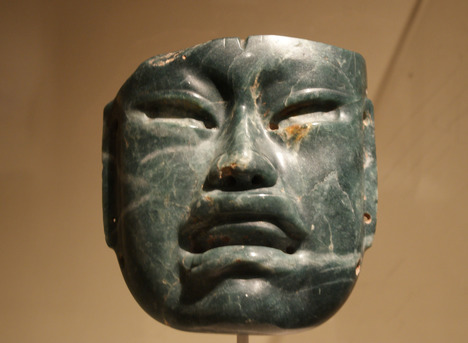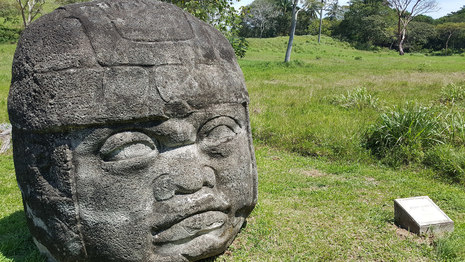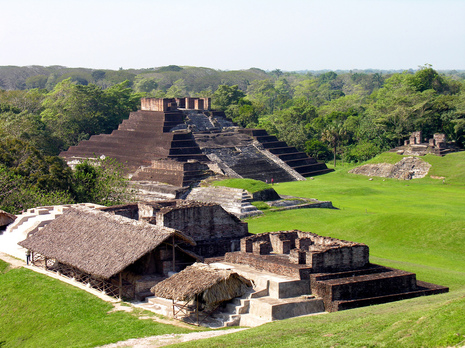BACKGROUND
|
The Olmec civilization flourished in Mexico before the time leading up to their collapse. Having been formed at around 1100 B.C.E., the society thrived for many centuries, until its collapse at around 300 B.C.E. (Soustelle 47). They lived in the coastal lowlands where climatic conditions, soil fertility, and rich natural resources created a perfect atmosphere in which allowed them to become a thriving agricultural society. La Venta was the last remaining main city of the Olmec. By 300 BCE, this great city saw depopulation and abandonment as decline set in. The eventual collapse of the Olmec followed soon after (Lockard 101-02).
|
HUMAN IMPACT ON ENVIRONMENT
The Olmec relied heavily on agriculture in order to make a living because of the rising population levels. Unfortunately, their agriculture consisted of only a limited number of crops, which caused the soil to become "exhausted very rapidly," therefore leading to the extensive degradation of precious lands (Bernal, Heydon, Horcasitas 22). Over farming and continuous use of fragile lands proved to have severe consequences as its effects caused tectonic upheavals to strike the society. This resulted in the riverine environment no longer having the capacity nor capability to support agriculture, which depended on a natural irrigation system, or other everyday activities (Diehl 82). The loss of this crucial natural resource crippled the society and may have greatly contributed to the Olmec’s decline and collapse.
CLIMATE CHANGE
The Olmec depended heavily on a few crops for survival. Such reliance on a relatively small amount of subsistence meant that when climate change occurred, it impacted the society on a substantial scale (Bernal et al. 22). They lived in the tropical lowlands of Mexico, where volcanoes dominated the environment and left devastating impacts. Volcanic eruptions blanketed the land with ash throughout this time period, forcing migration out of the area. These eruptions affected agricultural production, a vital source of food for the entire civilization (VanDerwarker 21-22). This is another factor that most likely contributed to the collapse of their society.
RELATIONS WITH HOSTILE SOCIETIES
Evidence of warfare is persistent in what remains of the Olmec civilization. Religious sculptures and centers that were produced through intensive labor and were constructed from rare materials were purposefully and systematically destroyed during the years leading up to their collapse, leading many to believe that hostile tribes and local peoples could have contributed to the abandonment of the society over the years. With all the effort put into building their elaborate statues, it is unlikely that friendly relations between the Olmec and neighboring societies always occurred (Tainter).
RELATIONS WITH NEIGHBORING FRIENDLY SOCIETIES
 Jade masked sculpted by the Olmec people.
Jade masked sculpted by the Olmec people.
They traded with neighboring Mesoamerican societies, who were largely influenced by Olmec culture and traditions. They were particularly interested in the trading of "prestige goods" (Pool 10). Extravagant iron, mirrors, jade, and serpentine were traded (Pool 10-11). Soon, the city was characterized by elaborate and extensive trade routes. The civilization experienced economic prosperity with goods flowing in and out of the city. However, trade eventually dissolved for the Olmec as hostility and warfare built up with neighboring societies. The once elaborated jade sculptures that characterized the civilization and were crafted by skilled artisans were no longer produced as trade with friendly neighbors dried up. This most likely had a profound effect on the social structure of the Olmec civilization because the wealth and power of the ruling elites depended on these elaborate trade routes (Morley & Bernard 252).
SOCIETY'S RESPONSE TO PROBLEMS
 One of seventeen giant stone heads that were built by the Olmec representing human heads.
One of seventeen giant stone heads that were built by the Olmec representing human heads.
The Olmec developed a social class system in which there was a ruling class of elites and a working class of peasants who provided services for the elites. Evidence of this division of class is seen in the "settlement patterns" of The Olmec, which clearly show a form of "political hierarchy" (Pool 11). As the economy prospered, the classes became more distinct. The
elites controlled most of the wealth and had access to most of the exotic goods. The power of the elites were shown in the colossal heads found scattered around the ruins of the Olmec. These heads are believed to be modeled after Olmec rulers. With the immense labor that is contributed in building each statue, it is merely a glimpse and a testimony to how much power the rulers had (Pool 10). Social inequalities between the classes most likely resulted in the “dissatisfaction of the peasantry,” which most likely contributed to the abandonment of the society (Kirkwood 20) .
elites controlled most of the wealth and had access to most of the exotic goods. The power of the elites were shown in the colossal heads found scattered around the ruins of the Olmec. These heads are believed to be modeled after Olmec rulers. With the immense labor that is contributed in building each statue, it is merely a glimpse and a testimony to how much power the rulers had (Pool 10). Social inequalities between the classes most likely resulted in the “dissatisfaction of the peasantry,” which most likely contributed to the abandonment of the society (Kirkwood 20) .
DOES DIAMOND'S FRAMEWORK APPLY TO THE OLMEC?
The Olmec exhibit all five points in Diamond's framework when it comes to factors that help explain and contributed to their collapse. His framework effectively explains the collapse of the Olmec. The Olmec experienced human impact on environment, climate change, complex relations with neighboring and hostile neighbors, and their political, economic, and cultural views caused them to overlook inequalities plaguing the society, which all eventually contributed to their collapse.
The point in Diamond's framework of human impact on the environment contributing to collapse applies to the Olmec civilization. The Olmec contributed to the degradation of the land that they strictly depended on for food. These anthropogenic fueled problems weakened the resource that they relied heavily upon for survival.
The point in Diamond's framework of climate change contributing to collapse applies to the Olmec civilization. Due to the coastal location of the Olmec's great cities, they were subject to volcanic eruptions. These eruptions would blanket the land with volcanic ash, leaving the Olmec unable to continue with the agriculture that they came to rely heavily upon.
The point in Diamond's framework of relations with friendly neighbors contributing to collapse applies to the Olmec civilization. The drying up of the Olmec trade routes contributed to their collapse. The power and wealth that characterized the great city suffered immensely as trade routes were used less and less often and as hostile neighbors built up.
The point in Diamond's framework of relations with hostile societies contributing to collapse applies to the Olmec civilization. Neighboring hostile societies crippled the important trade routes that the Olmec relied on as a source of power and wealth. This most likely contributed to the collapse of their society.
The point in Diamond's framework of society's response to problems contributing to collapse applies to the Olmec civilization. A distinct ruling and lower working class emerged from the Olmec. These inequalities caused impatience and discontent in the lower working class, which eventually contributed to the collapse of the Olmec.
The point in Diamond's framework of human impact on the environment contributing to collapse applies to the Olmec civilization. The Olmec contributed to the degradation of the land that they strictly depended on for food. These anthropogenic fueled problems weakened the resource that they relied heavily upon for survival.
The point in Diamond's framework of climate change contributing to collapse applies to the Olmec civilization. Due to the coastal location of the Olmec's great cities, they were subject to volcanic eruptions. These eruptions would blanket the land with volcanic ash, leaving the Olmec unable to continue with the agriculture that they came to rely heavily upon.
The point in Diamond's framework of relations with friendly neighbors contributing to collapse applies to the Olmec civilization. The drying up of the Olmec trade routes contributed to their collapse. The power and wealth that characterized the great city suffered immensely as trade routes were used less and less often and as hostile neighbors built up.
The point in Diamond's framework of relations with hostile societies contributing to collapse applies to the Olmec civilization. Neighboring hostile societies crippled the important trade routes that the Olmec relied on as a source of power and wealth. This most likely contributed to the collapse of their society.
The point in Diamond's framework of society's response to problems contributing to collapse applies to the Olmec civilization. A distinct ruling and lower working class emerged from the Olmec. These inequalities caused impatience and discontent in the lower working class, which eventually contributed to the collapse of the Olmec.
Photos used under Creative Commons from archer10 (Dennis) (73M Views), archer10 (Dennis) (Taking a break)

